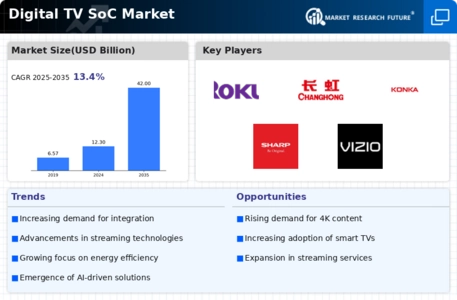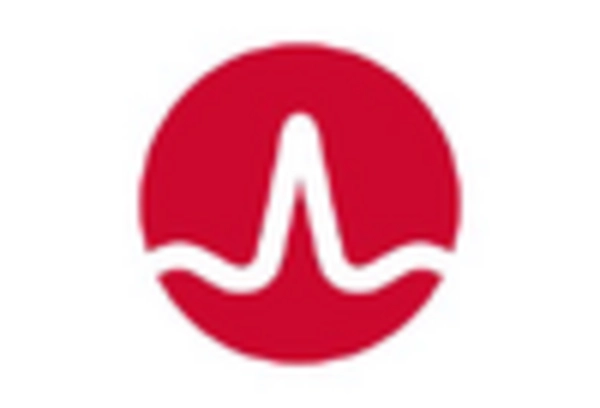Emergence of Smart TVs
The rapid adoption of smart TVs is reshaping the Digital TV SoC Market. As consumers gravitate towards devices that offer integrated internet capabilities and access to a plethora of applications, the demand for sophisticated SoCs that can support these functionalities is increasing. Recent statistics indicate that smart TVs accounted for over 70% of total TV sales in 2025, underscoring the shift in consumer preferences. This trend compels manufacturers to innovate and develop SoCs that not only provide robust processing power but also ensure seamless user interfaces and connectivity. Thus, the Digital TV SoC Market is experiencing a transformative phase driven by the smart TV revolution.
Growth of Streaming Services
The proliferation of streaming services has significantly influenced the Digital TV SoC Market. As platforms like Netflix, Amazon Prime, and Disney+ expand their offerings, the need for SoCs that can efficiently decode and render high-quality streaming content becomes paramount. Market analysis shows that the number of streaming subscribers has reached over 1 billion, creating a substantial demand for compatible devices. This surge necessitates the development of SoCs that not only support various codecs but also enhance user experience through faster processing and improved graphics. Thus, the Digital TV SoC Market is evolving to meet the requirements of this burgeoning sector.
Focus on Cost-Effective Solutions
The emphasis on cost-effective solutions is a significant driver in the Digital TV SoC Market. As competition intensifies, manufacturers are increasingly focused on developing SoCs that deliver high performance at lower costs. This trend is particularly evident in emerging markets, where price sensitivity is a critical factor influencing consumer purchasing decisions. Market Research Future reveal that the demand for budget-friendly smart TVs is rising, prompting manufacturers to create SoCs that balance affordability with advanced features. Consequently, the Digital TV SoC Market is likely to witness a surge in innovative, cost-efficient solutions that cater to diverse consumer needs.
Advancements in Connectivity Technologies
The evolution of connectivity technologies, such as 5G and Wi-Fi 6, is a crucial driver for the Digital TV SoC Market. These advancements enable faster data transmission and improved streaming quality, which are essential for modern digital television experiences. As consumers increasingly adopt smart TVs and connected devices, the demand for SoCs that can leverage these technologies is on the rise. Market data suggests that the adoption of 5G technology is expected to reach 1.5 billion subscriptions by 2025, further propelling the need for SoCs that can handle high-bandwidth applications. Consequently, the Digital TV SoC Market is adapting to these technological shifts to enhance performance and connectivity.
Rising Demand for High-Definition Content
The increasing consumer preference for high-definition content is a pivotal driver in the Digital TV SoC Market. As viewers seek enhanced visual experiences, manufacturers are compelled to innovate and produce SoCs that support 4K and even 8K resolutions. This trend is reflected in the market data, which indicates that the demand for 4K televisions has surged, with projections suggesting that by 2026, over 50% of TV shipments will be 4K models. Consequently, the Digital TV SoC Market is witnessing a shift towards advanced processing capabilities to accommodate these high-resolution formats, thereby driving growth and competition among SoC manufacturers.

















Leave a Comment